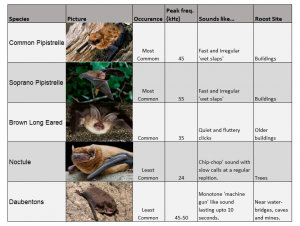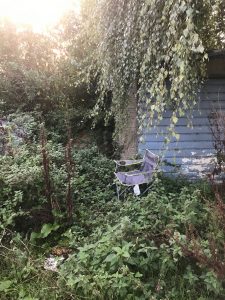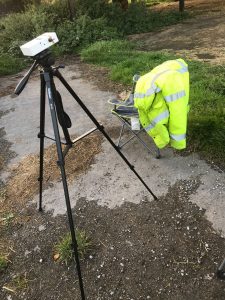Written by Erin Hull
Bats are protected by law, meaning that you cannot disturb, damage or remove a bat in its natural habitat. therefore, if you are planning a project which may have the chance of disturbing a bat, it is a requirement to get a bat survey done to the area. This may be a planning application, a barn conversion, removal of a hedgerow, introduction of wind turbines, and so much more. An experienced bat surveyor will not only listen for bats during the bat survey season (May-September) they will also assess the area/building for potential signs of their presence, including potential roosting sites. If there is bat presence this does not mean that the project cannot go ahead, it means the correct measures need to be put into place in order to ensure the bats safety. There are a range of mitigation and compensation methods that can be enforced, from moving the location of the project to creating, restoring or improving roosts (and replacing any that will be damaged or removed).
I must admit, I wasn’t familiar with bat surveying until the end of my time at University, when I began to search for jobs. Lots of jobs ask for experience within the sector, which is very hard to have completed when you are still a uni student. Therefore, quite a few companies open up spaces for people like me to come in and do freelance surveying! Any experience is good experience, you may really enjoy something that previously hadn’t appealed to you, whilst gaining lots of new skills.
Bat Identification in my area:

*pictures from https://www.woodlandtrust.org.uk/ animal profiles.
Emergence Survey
The first evening I arrived on site for 18:15 just before the sun began to go down. Here I was met with 2 others, the leader and another freelancer. We were briefed on what we had to do… study an abandoned house to see if any bats were roosting in there. Each of us having a different side of the house to observe for the next two hours.
 We were each equipped with a clipboard, site map, data collection sheet, bat detector and a torch. When we saw a bat we would jot down the time heard, which frequency we heard them best at, and if seen mark their location/direction on the map. The leader had set up some bat recording devices around us so that she could revisit the data and properly identify the bats through their calls. She does this by listening to the data at the times we recorded hearing a bat. This limits the chances of errors as the bats are identified correctly by a professional.
We were each equipped with a clipboard, site map, data collection sheet, bat detector and a torch. When we saw a bat we would jot down the time heard, which frequency we heard them best at, and if seen mark their location/direction on the map. The leader had set up some bat recording devices around us so that she could revisit the data and properly identify the bats through their calls. She does this by listening to the data at the times we recorded hearing a bat. This limits the chances of errors as the bats are identified correctly by a professional.
On the outcome of this survey we could not see any evidence of them roosting in the building. From all sides of the site we heard and saw multiple bats however they were either commuting or feeding nearby. This matched the data from 5 years ago when the survey was last conducted in this location.
Transect Survey
 For this survey I arrived on site at 18:00 as the nights started to draw in faster as we approach winter. Again there were three of us taking the surveys, however, this time the site included a compound and two large fields with developments nearby. The aim of this survey is to walk around the designated section, to see if we could see/hear any bats along the transect.
For this survey I arrived on site at 18:00 as the nights started to draw in faster as we approach winter. Again there were three of us taking the surveys, however, this time the site included a compound and two large fields with developments nearby. The aim of this survey is to walk around the designated section, to see if we could see/hear any bats along the transect.
Similar to the last survey I was equipped with a clipboard, site map, data collection sheet, bat detector and a head torch as I’d be walking around.
This survey wasn’t as successful with only 3 recordings of bats from one corner of the site. Maybe due to it being an open field so there were less places for the bats to hide and fly between. Still an enjoyable experience gaining some fun skills using new equipment and techniques.
Equipment used:
 Bat Detector- bats hunt for insects at night, using a high frequency system called echolocation. Bat calls are usually pitched at too high a frequency for humans to hear, but they can be heard using bat detector devices.
Bat Detector- bats hunt for insects at night, using a high frequency system called echolocation. Bat calls are usually pitched at too high a frequency for humans to hear, but they can be heard using bat detector devices.
Data Collection Sheet- to record all sightings including frequency, time and location.
Pencil- to write down your observations.
Map- of the site in order to record sightings of bats (and of the transect route if doing a transect survey).
Hi-vis- So people can see you whilst you are working.
Watch/phone- in order to tell the time.
Bat recording device- monitor the ultrasonic echolocation calls of bats for species identification and activity measurement, data to look back on after the survey.
How can you get involved?
There will be lots of companies around your area that carry out surveys like this. Mine was through Smeeden Foreman who are local to me, they specialise in landscapes, ecology and arboriculture. If you are UK based it might be worth checking out these websites for more information about volunteering https://www.bats.org.uk/ and https://batsinchurches.org.uk/get-involved/volunteer-bat-survey/. Bat surveys need to be renewed due to the seasonal changes of where bats roost… meaning that surveys need to be done every year/two years to ensure the site is still ok to have work done.
Information gathered by Erin Hull from her own knowledge and using these sources: https://www.ecologybydesign.co.uk/protected-species-survey/bat-survey and https://www.gov.uk/guidance/bats-surveys-and-mitigation-for-development-projects#mitigation-and-compensation-methods.

